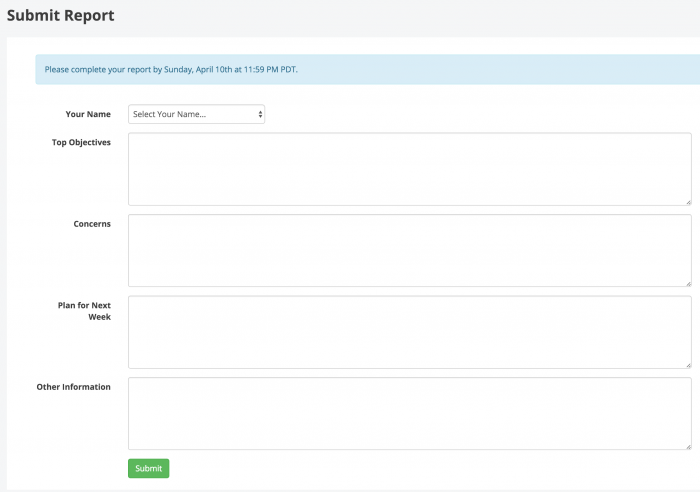In a startup team, there is nothing more important than clear communication. If we get communication right, we are far more likely to build the right product, serve customers effectively and hit the goals necessary to raise funding and grow. The problem is, most startups move ridiculously quickly, which is a perfect recipe for communication to get lost in the shuffle. For this reason, I always implement my #1 favorite management tool: weekly reporting.
Weekly reporting is simply having each member of the team fill out a brief form at the end of each week with a summary of what they worked on, results, concerns and general information to share with the team. Each form submission should be emailed to everyone on that team. This simple process is amazing for keeping everyone aligned. Let’s break down what an ideal weekly report looks like.
Each weekly report has 4 key pieces of information to collect:
- Top Objectives: what did you work on this week, and status of each?
- Concerns: what is broken? Let’s air it out in writing so we can address it.
- Plan for Next Week: what is upcoming so we can confirm we’re aligned?
- Other Information: what details should the team know (e.g. travel plans)?

Each employee should take 10-15 minutes to write their report on Friday, and I give them until end of day Sunday to complete it. Then over the weekend and early Monday morning, I review and reply to every single report. This is incredibly helpful for several reasons:
Accountability
Startups often lack structure (usually a good thing!) but that means it is difficult to track initiatives and easily hold team member accountable for getting things done. Weekly Reporting creates a written record, i.e. a paper trail, that documents precisely what is getting done and when.
When I do a 1-1 meeting, I pull up the weekly reports from the last month to help guide our conversation. If someone isn’t performing, I use the weekly reports as clear evidence that objectives are not being accomplished.
Alignment
Alignment means the entire team is on the same page, understands the big objectives and goals, and is executing on the right initiatives that help us accomplish those goals. Of course, it’s easy to get misaligned, where not everyone understands where we are going and why. Having communication in writing that outlines what everyone is focusing on and their concerns is radically simple, and wildly effective for keeping the team aligned.
Transparency
Creating visibility into everyone’s top objectives, concerns and action plans gives the rest of the team piece of mind. It helps confirm that they are working on the right things, and that the areas they are not focusing on are being effectively covered by someone else. Everyone operates better when they are “in the know,” and weekly reporting is one of the lowest effort tools to provide that visibility.
Ease of Communication
One of the things I love about weekly reports is that each one serves as a spark for a conversation. For example, suppose my colleague submits a report and outlines a concern about one of our marketing campaigns. I can simply reply-all to that email and start a conversation with the team about that concern. If it wasn’t for the weekly report, he may have not felt comfortable raising the concern, or it might have simply got lost in the shuffle.
How do I get started?
1. Be consistent
The team should be in a rhythm where every Friday or weekend they take 10-15 minutes to complete their report, and know that they’ll be able to read everyone else’s over the next few days. This becomes an excellent weekly ritual to keep everyone on the same page.
2. Make it a requirement
Weekly reports only work if the manager (typically COO or CEO) mandates it and personally does a report as well. The time investment is so low, and value add is so high. I have implemented weekly reporting for every single one of my teams, from leadership to marketing.
3. Reply to every report
To show that you are reading and using the reports, reply to each one. The reply might only be one sentence, but it demonstrates acknowledgement, and encourages participation. If a team member is focusing on all of the right objectives, tell them! If not, tell them as well.
4. Give praise, address concerns
The weekly report is a fantastic opportunity to give public praise in writing. I often reply “Thanks Joe, project X looks right on point. Well done!” Not only is that great praise for Joe, but it publicly demonstrates to the rest of the team what we consider “well done” to mean.
5. Avoid status meetings
A huge benefit of weekly reports is that they eliminate the need for status meetings. It is far more efficient for everyone to provide their status updates in writing with the weekly report. We reserve our in-person meeting time for strategic discussion.
6. Keep it in email
Everyone already uses email, so I make sure to keep the entire weekly reporting process in email. The weekly reminder gets sent as an email, the reporting form is filled out in the web browser, and the actual report gets sent to the group as an email.
7. Avoid complexity
If you are using a tool and can’t set up weekly reporting in literally 2 minutes, look elsewhere. We have to remember that nobody wants to have to manage “another service.” When automated, weekly reporting should act as an extension of the manager themselves, not another branded app that employees have to learn how to use.
Ultimately, weekly reporting has to be simple and easy, or else team members won’t get it done. If it is effectively automated, built into the apps and workflow our team already uses, then it becomes an incredible communication tool.